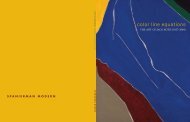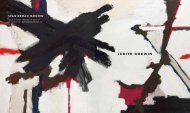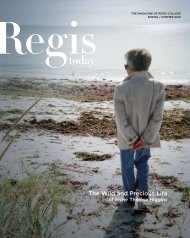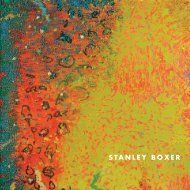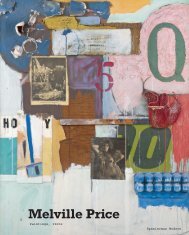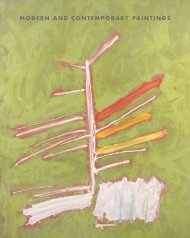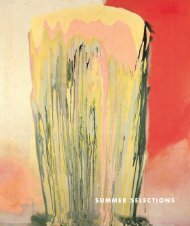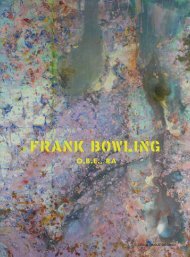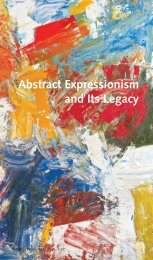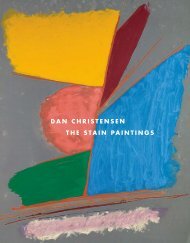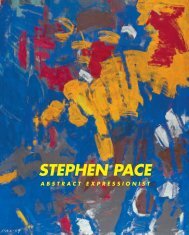View the catalogue - Spanierman Modern
View the catalogue - Spanierman Modern
View the catalogue - Spanierman Modern
You also want an ePaper? Increase the reach of your titles
YUMPU automatically turns print PDFs into web optimized ePapers that Google loves.
hues with modulated ones. Again her works<br />
are of two dispositions. Some are rich, with<br />
cursive lines we ponder, only to realize <strong>the</strong><br />
cursive lines’ bounding areas echo nature.<br />
They recall <strong>the</strong> sinuous contours of a cloud,<br />
<strong>the</strong> appearance of furled leaves rustled by<br />
a breeze, or traces of human form. O<strong>the</strong>rs<br />
are rich in rectilinear shapes. In <strong>the</strong>se, <strong>the</strong>re is<br />
a predilection for emphasizing <strong>the</strong> verticality<br />
of forms. In both she used hotter, more<br />
impassioned colors than she had earlier.<br />
One of her favorite combinations was alizarin<br />
crimson shouldered by brilliant orange or<br />
pink, <strong>the</strong> whole seemingly intensified by<br />
planes of cerulean blue or black. Toge<strong>the</strong>r<br />
<strong>the</strong>se colors glow with particular intensity.<br />
These works reveal <strong>the</strong> boldness of Park’s<br />
choices and allow us to take note of her sure<br />
touch in deploying paint with both brush<br />
and palette knife. Her use of <strong>the</strong>m in tandem<br />
fashioned tactile and varied surfaces.<br />
The inventiveness that emanated from<br />
<strong>the</strong>se images inspired Park to investigate<br />
ano<strong>the</strong>r art form. In <strong>the</strong> second half of <strong>the</strong><br />
decade, she turned to collage as had her<br />
contemporaries Lee Krasner and Conrad<br />
Marca-Relli. She took a distinctive approach<br />
to this form. Instead of <strong>the</strong> method of <strong>the</strong><br />
Cubists and Dadaists, whose collages were<br />
fashioned of random newsprint, wrappers,<br />
and <strong>the</strong> debris of real life, Park culled<br />
her earlier works for passages of color or<br />
brushwork she found interesting. She <strong>the</strong>n<br />
cut <strong>the</strong>m apart and gave <strong>the</strong>m new life<br />
by arranging <strong>the</strong>m in a new context. The<br />
resulting compositions retain <strong>the</strong>ir twodimensionality,<br />
with nearly all <strong>the</strong> illusionistic<br />
space squeezed from <strong>the</strong>m, although <strong>the</strong><br />
pasted papers on successive planes hint at<br />
variable pictorial depths. In keeping with<br />
her aes<strong>the</strong>tic, <strong>the</strong>se newly minted images<br />
are abstract but have a stringency lacking<br />
in Krasner’s Matisse-inspired forms or in<br />
Marca-Relli’s ephemeral human ones.<br />
The collages have ano<strong>the</strong>r value, however.<br />
Their abutting planes, varied in every way,<br />
opened a vista that <strong>the</strong> artist explored in <strong>the</strong><br />
1960s. Three works in <strong>the</strong> exhibition reveal<br />
this trajectory, two that are untitled, and one<br />
called Tara. Far from <strong>the</strong> earnestness of her<br />
earliest works as well as from <strong>the</strong> dignified<br />
images of <strong>the</strong> mid-fifties works, <strong>the</strong>se new<br />
images are platonic in <strong>the</strong>ir square format<br />
and soft and sensuous in <strong>the</strong>ir mixture of<br />
pure color with luminous blended hues.<br />
Later in life, Park evinced an avid interest in<br />
Mondrian’s Neo-plasticism, an association<br />
to which Helen Harrison gave recognition<br />
in 1981. One wonders if this interest was<br />
already latent and how much it inspired <strong>the</strong><br />
overall shape of <strong>the</strong>se works and <strong>the</strong> notion<br />
of a geometricized pictorial field. However,<br />
different from her earlier images in <strong>the</strong>se<br />
later ones, <strong>the</strong> colors whisper and shout.<br />
Her vision is at once more poetic and more<br />
joyous, leading to <strong>the</strong> works of <strong>the</strong> next<br />
phase of her career, to be explored in<br />
ano<strong>the</strong>r exhibition. While reflecting many<br />
strains within <strong>the</strong> abstract art of her time,<br />
<strong>the</strong>se works also reveal Park’s development<br />
of an individualist expressive identity, which<br />
deserves a place of its own in <strong>the</strong> history<br />
of <strong>the</strong> art of her time.<br />
Anne Abeles, Ph.D.<br />
9



